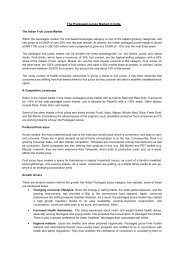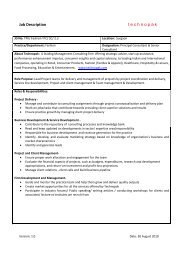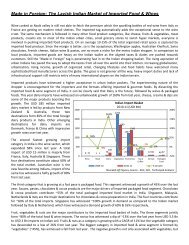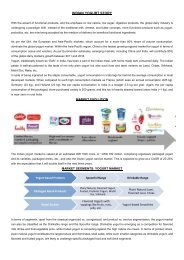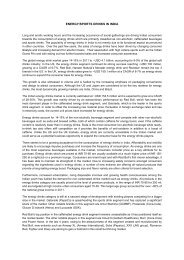a quarterly report by - Technopak
a quarterly report by - Technopak
a quarterly report by - Technopak
Create successful ePaper yourself
Turn your PDF publications into a flip-book with our unique Google optimized e-Paper software.
Impact on Warehousing<br />
perspective<br />
a quar terly repor t <strong>by</strong><br />
Volume 02 / 2009<br />
| Volume 02<br />
New or enlarged warehouses will have to be designed/re-designed. <strong>Technopak</strong> estimates that for most<br />
organisations, 6-8 locations will have mega warehouses with complex operations in the near future. Thus,<br />
modernisation of key warehouses is strongly recommended on account of:<br />
•Large<br />
sizes, high throughputs and more complex operations<br />
•Increasing<br />
level and variety of service required <strong>by</strong> customers, especially organised retailers<br />
•Increasing<br />
scarcity of skilled labour and real estate requiring vertical and mechanised warehouses<br />
Impact on Service Level<br />
The key fallout of GST aligned networks is fewer warehouses but this also has two implications on customer<br />
service:<br />
•Longer Lead-times to Customers: This would not be an issue as long as the network redesign exercise<br />
puts a minimum lead time/distance constraint while serving customers in the new network.<br />
• Improved Assortment: Often SKUs needed <strong>by</strong> customers are not available at the warehouse meant<br />
to serve them although they may be idling at another warehouse. This is especially true for slow moving<br />
items. With stock aggregated at fewer warehouses, the planning and assortment availability improves for<br />
slow moving SKUs.<br />
Thus, service to customers could be maintained or even improved in a network re-engineering exercise.<br />
The key here is to undertake a professional scientific exercise as opposed to manual experience based<br />
methods that many firms have used for designing their legacy networks.<br />
Our Approach<br />
A scientific tool-based redesigning of the distribution network would be helpful in delivering optimal logistics<br />
and inventory carrying costs without compromising on service levels to customers. Exhibit 8 illustrates this<br />
scientific tool-based approach in greater detail.<br />
Exhibit 8<br />
Inputs<br />
Model Design<br />
& Creation<br />
Output<br />
Network Re-engineering Approach<br />
• Collate demand pattern and existing supply chain costs of manufacturing, freight, handling, fixed warehousing, variable<br />
warehousing and taxes (VAT / CST / Excise)<br />
• Understand existing service levels and logistics constraints<br />
• List the external business environment factors affecting network design and performance<br />
• Identify candidate locations for warehouses & hubs based on <strong>Technopak</strong>’s understanding of the Indian logistics sector<br />
• Design a Mixed Integer Linear Program (MILP) model based on a firm’s internal and external business environment<br />
translating into appropriate variables, constraints & assumptions<br />
• Pre-processing of input data to improve model performance and ensure accuracy of results<br />
• Scenario building & sensitivity analysis<br />
• Number, size & location of hubs & warehouses<br />
• Network linkages between various supply chain entities<br />
• Optimal transport modes and mix<br />
GST : Impact on the Supply Chain |<br />
28



